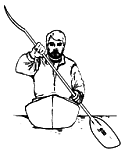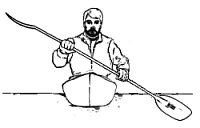
 |
|
|
#1 |
|
bing!
Join Date: Mar 2007
Location: socal
Posts: 246
|
Paddle Talk
After a couple of years kayak fishing, Ive suddenly developed an interest in paddling. Likely from my frustration in my kayak's tracking and desire to improve my surf launching and landing performance.
Here is some useful info ... The truth about kayak tracking - The real truth, according to a leading kayak experts, is that "tracking" is 80% paddling and 20% design. Tracking IS paddling. Proper paddle hand placement - To find your hand placement on your paddle, start by placing the center of the paddle on the top of your head, your elbows should form more or less a 90 degree angle between the forearm and upper arm. There should be an equal amount of paddle shaft and blade beyond both of your hands. In buying a paddle, know if you are a low angle or high angle paddler. High angle paddler  Low angle paddler  The angle of your paddle technique will dictate how long your paddle should be, and what style of blade you should get. The high angle paddler (when the paddle enters right next to the hull) is more suited for surf, white water as it provides more power per stroke. It is also easier to control the kayak while "surfing" due to the usual short length of a high angle paddle (210-220cm). A disadvantage is that it has a tendency to provide less tracking "feel" for the novice. A paddle for the high angle style is properly sized to the paddler when it has between 1 to 3 palm widths between the paddle and the hand grip placement. Picture of a kayaker using a bracing stroke to control the kayak in a surf environment. In this picture, it is apparent how a longer paddle will be a disadvantage and a shorter paddle easier to control.  Note the symmetrical blade style preferred for its power in this photo  High angle paddle blade style  Another high angle blade  Here is a video of a high angle paddler... http://www.expertvillage.com/videos/...ard-stroke.htm Low angle paddling is the usual touring / long distance style. It may provide less power due to the stretched out water entry of the blade (about 1.5 to 3 feet from the side of the hull) and also the blade style. You will get more tracking "feel" as the leverage of the stroke will give the paddler immediate feedback to the kayaks bow. Low angle kayak paddle are usually 230-240 cm long. A paddle for the low angle style is properly sized to the paddler when it has 3 or more palm widths between the paddle and the hand grip placement. Picture of low angle paddle blade  Traditional eskimo touring paddle blades  Low angle paddling conserves energy and provides a more relaxed pace. Surf launching with a "longer" low angle paddle is a bit more difficult because of the "usually" thinner blade, larger leverage of a longer paddle. How to hold your paddle http://www.expertvillage.com/videos/...ing-paddle.htm Turning by edging http://www.expertvillage.com/videos/...ing-edging.htm If there is interest in pursuing this subject further, I do have some more info. Also, if you have your own tips, post it right here. Last edited by peguinpower; 11-19-2007 at 09:14 PM. |
|
|

|
|
|